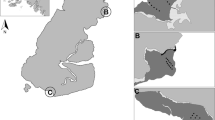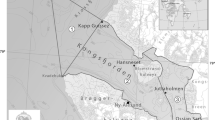Abstract
The fauna inhabiting a Halodule wrightii meadow in Apalachicola Bay, Florida, was studied from March 1975 through Feburary 1976. The infaunal community was sampled by monthly coring. Fifty-eight species were recorded, averaging 35 species per month. A maximum faunal abundance of 104,338 organisms per m2 in April was one of the highest infaunal densities recorded in the literature. Sixteen species accounted for 84% of the total numbers and 80% of the total biomass over the study period. Numerical dominants were Hargeria rapax, Heteromastus filiformis, Ampelisca vadorum, Aricidea fragilis, and oligochaetes. Biomass dominants were Tagelus plebeius, Neritina reclivata, Ensis minor, and Haploscoloplos fragilis. Life history notes are given for several dominant species. Epibenthic fishes and macroinvertebrates were sampled by monthly trawling. Twenty-three species of fishes (mostly juveniles) were collected near the coring site, with most species and individuals recorded during the months May through September. Bairdiella chrysoura, Orthopristis chrysoptera, and Lagodon rhomboides comprised 76% of the total fish numbers. Eleven species of macroinvertebrates were collected mainly in June and July. Callinectes sapidus comprised 61% of the total invertebrate numbers. It is postulated that the influx of juvenile fishes and crabs into the Halodule meadow in summer months leads to a coincident decline in infaunal population densities (number per m2) through predation. Infaunal biomasses are largely unaffected by these predators since the biomass dominants are large or deep-burrowing species.
Similar content being viewed by others
Literature Cited
Bloom, S. A., J. L. Simon, and V. D. Hunter. 1972. Animal-sediment relations and community analysis of a Florida estuary. Mar. Biol. 13:43–56.
Carr, W. E. S., and C. A. Adams. 1973. Food habits of juvenile marine fishes occupying seagrass beds in the estuarine zone near Crystal River, Florida. Trans. Am. Fish. Soc. 102:511–540.
Folk, R. L. 1974. Petrology of Sedimentary Rocks. Hemphill Publishing Co., Austin, Texas. 63 p.
Holland, A. F., and J. M. Dean. 1977. The biology of the stout razor clam Tagelus plebeius: I. Animal-sediment relationships, feeding mechanism, and community biology. Chesapeake Sci. 18:58–66.
Humm, H. J. 1973. Seagrasses, p. IIIC 1–10. In J. I. Jones, R. E. Ring, M. O. Rinkel, and R. E. Smith (eds.), A Summary of Knowledge of the Eastern Gulf of Mexico 1973. State University System Institute of Oceanography, St. Petersburg, Florida.
Ingram, R. L. 1971. Sieve analysis, p. 49–67. In R. E. Carver (ed.), Procedures in Sedimentary Petrology. Wiley-Interscience, New York.
Livingston, R. J. 1980 Critical habitat assessment of the Apalachicola estuary and associated coastal areas. Final Report (unpubl.), Coastal Plains Regional Commission, Tallahassee, Florida. 218 p.
Livingston, R. J., P. F. Sheridan, B. G. McLane, F. G. Lewis, III, and G. J. Kobylinski. 1977. The biota of the Apalachicola Bay system: functional relationships, p. 75–100. In R. J. Livingston and E. A. Joyce, Jr. (eds.), Proceedings of the Conference on the Apalachicola Drainage System. Fla. Dept. Nat. Res., Mar. Res. Lab. Publ. 26.
Mahadevan, S. 1979. A review and evaluation of the “316 Demonstration” (Volume IV-Benthos) by Florida Power Corporation on the Anclote Generating Unit No. 1. Mote Marine Lab., Tech. Rept. Contract #68-01-5016. 101 p.
Maurer, D., L. Watling, P. Kinner, W. Leathem, and C. Wethe. 1978. Benthic invertebrate assemblages of Delaware Bay. Mar. Biol. 45:65–78.
McBee, J. T., and W. T. Brehm. 1979. Macrobenthos of Simmons Bayou and an adjoining residential canal. Gulf Res. Rep. 6:211–216.
McCall, P. L. 1977. Community patterns and adaptive strategies of the infaunal benthos of Long Island Sound. J. Mar. Res. 35:221–266.
Mills, E. L. 1967. The biology of an ampeliscid amphipod crustacean sibling species pair. J. Fish. Res. Board Can. 24:305–355.
Moore, H. B., L. T. Davies, T. H. Fraser, R. H. Gore, and N. R. Lopez. 1968. Some biomass figures from a tidal flat in Biscayne Bay, Florida. Bull. Mar. Sci. 18:261–279.
Myers, A. C. 1977. Sediment processing in a marine subtidal sandy bottom community. II. Biological consequences. J. Mar. Res. 35:633–647.
O'Connor, J. S. 1972. The benthic macrofauna of Moriches Bay, New York. Biol. Bull. 142:84–102.
Odum, W. E., and E. J. Heald. 1972. Trophic analysis of an estuarine mangrove community. Bull. Mar. Sci. 22:671–738.
O'Gowar, A. K., and J. W. Wacasey. 1967. Animal communities associated with Thalassia, Diplanthera, and sand beds in Biscayne Bay. I. Analysis of communities in relation to water movements. Bull. Mar. Sci. 17:175–210.
Orth, R. J. 1973. Benthic infauna of eelgrass, Zostera marina, beds, Chesapeake Sci. 14:258–269.
Santos, S. L., and J. L. Simon. 1974. Distribution and abundance of the polychaetous annelids in a south Florida estuary. Bull. Mar. Sci. 24:669–689.
Sheridan, P. F. 1979. Trophic resource utilization by three species of sciaenid fishes in a northwest Florida estuary. Northeast Gulf Sci. 3:1–15.
Stoner, A. W. 1979. Species-specific predation on amphipod Crustacea by the pinfish Lagodon rhomboides: mediation by macrophyte standing crop. Mar. Biol. 55:201–207.
Stoner, A. W. 1980. Feeding ecology of Lagodon rhomboides (Pisces: Sparidae): variation and functional responses. Fish. Bull. 78:337–352.
Virnstein, R. W. 1977. The importance of predation by crabs and fishes on benthic infauna in Chesapeake Bay. Ecology 58:1199–1217.
Watling, L. 1975. Analysis of structural variations in a shallow estuarine deposit-feeding community. J. Exp. Mar. Biol. Ecol. 19:275–313.
Young, D. K., and M. W. Young. 1977. Community structure of the macrobenthos associated with seagrass of the Indian River estuary, Florida, p. 359–381. In B. C. Coull (ed.), Ecology of Marine Benthos, Univ. of South Carolina Press, Columbia, South Carolina.
Author information
Authors and Affiliations
Rights and permissions
About this article
Cite this article
Sheridan, P.F., Livingston, R.J. Abundance and seasonality of infauna and epifauna inhabiting a Halodule wrightii meadow in Apalachicola Bay, Florida. Estuaries 6, 407–419 (1983). https://doi.org/10.2307/1351400
Received:
Accepted:
Issue Date:
DOI: https://doi.org/10.2307/1351400




